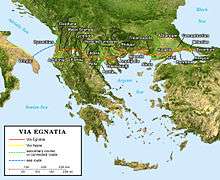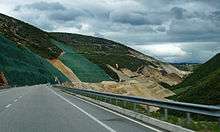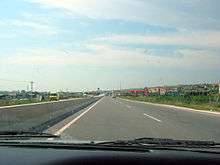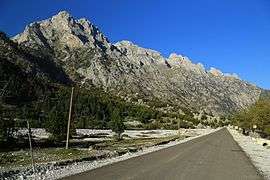Highways in Albania


Highways in Albania form part of the recent Albanian road system. Following the collapse of communism in 1991, highways began to be modernized with the construction of the first highway in Albania, SH2, connecting Tirane with Durres via Vora. Since the 2000s, main roadways have drastically improved, though lacking standards in design and road safety.[1][2] This involved the construction of new roadways and the putting of contemporary signs. However, some state roads continue to deteriorate from lack of maintenance while others remain unfinished.
History

Since antiquity, the area of modern Albania served as an important caravan crossroad route between empires through the Via Pubblica and Via Egnatia. The former passed through northern Albania, while the latter linked Rome with Byzantium (later Constantinople), through Durres on the Adriatic Sea. During World War I, occupying forces opened up new road sections mainly in the mountainous areas of the country. In King Zog's period, further road construction took place near Vlora and at Krraba Pass between Tirana and Elbasan.
The total length of Albania's roads more than doubled in the first three decades after World War II, and by the 1980s almost all of the country's remote mountain areas were connected, either by dirt or paved roads, with the capital city of Tirana, and ports on the Adriatic and Ionian Sea. Private car ownership was not allowed and the only vehicles circulating were state-owned trucks, agricultural and official's vehicles, buses, motorcycles, and bicycles. The country's roads, however, were generally narrow, poorly marked, pocked with holes, and in the early 1990s often crowded with pedestrians and people riding mules, bicycles, and horse-drawn carts.
The biggest road project in the history of Albania is the construction of the Rrëshen-Kalimash dual carriageway(or the A1 Motorway) from 2007 to 2010, linking Albania with Kosovo. The segment involved the carving of a mountainous terrain, and the construction of a 5.6 km long tunnel and dozens of bridges.[3] In October 2010, Prime Minister Sali Berisha announced plans to build several major highways.[4]
At present, major cities are linked with either new single/dual carriageways or well maintained roads. There is a dual carriageway connecting the port city of Durrës with Tirana, Vlorë, and partially Kukës. In fact, there are three formal motorway segments in Albania: Thumanë-Milot-Rrëshen-Kalimash (A1), Levan-Vlorë (A2), and partly Tirane-Elbasan (A3). Most rural segments continue to remain in bad conditions as their reconstruction has only began in the late 2000s by the Albanian Development Fund.[5]

Road system

All roads are property of Albanian Road Authority (Autoriteti Rrugor Shqiptar, former Drejtoria e Përgjithshme e Rrugëve) and maintained by Ndërmarrja Shtetërore Rruga-Ura. The government plans to create some toll highways in the near future. Albanian bitumen from Selenicë in Southern Albania is well known for its quality as it has been used on some European motorways.
A new road system has been introduced in the last decade and is classified as follows:[6]
| Type | Name | Definition |
|---|---|---|
| Motorway Road (Rrugë Autostradale) | Highest level of roadway marked as "A #" on a green field. | |
| |
State Road (Rrugë Shtetërore) | Main and most common level of roadway linking major cities marked as "SH #" on a blue field. |
| District Road (Rrugë Rrethi) | Lower level of roadway found between districts and marked as "Rr #" on a blue field. | |
| Municipal Road (Rrugë Komunale) | Lowest level of roadway typically found in rural areas. These segments are marked as "K #" on a white field though it is not observed on the ground. |
The major priority of the government in 2014 is the completion of unfinished roadways due to lack of funding. Another major priority is the completion of the Arbër Highway (Rruga e Arbërit) linking Tirana with the city of Debar (Republic of Macedonia) through the current SH6. Eventually, this superstradë will become part of European corridor 8 linking Albania with the Republic of Macedonia and Greece.[7] Another objective is the completion of the Tirana-Elbasan Highway Motorway (Autostradë) including the Krrabe Tunnel. Other important goals are the launch of toll highways, and the construction of the Southern Axis of Albania (Boshti i Jugut) passing across central and southern Albania. The completion of the Eastern Ring of Albania (Unaza Lindore) passing through Valbonë, Kukës, Krumë, Bulqizë and Librazhd is also a priority. In the mountainous areas, roads can be tight and windy with numerous serpentines and hairpins. When all corridors are completed, Albania will have an estimated 759 kilometers of highway linking it with its neighbors.
Despite considerable investments, some dual carriageways are partially up to either motorway or state road standards as they are badly configured, contain unfinished overpasses, uncontrolled access points, lack of fencing and either misplaced or missing road signs, inadequate entry and exit ramps, and are indiscriminately used by animals, mopeds, agricultural vehicles, and pedestrians.
Major roads



.jpg)


- Motorway roads:
 A1 Motorway (Thumanë-Milot–Rrëshen–Kalimash) part of the Albania–Kosovo Highway
A1 Motorway (Thumanë-Milot–Rrëshen–Kalimash) part of the Albania–Kosovo Highway A2 Motorway (Fier–Vlorë)
A2 Motorway (Fier–Vlorë) A3 Motorway (Tirana–Elbasan)
A3 Motorway (Tirana–Elbasan)
- State roads:
 SH1 Road (Tiranë–Shkodër–Hani i Hotit MNE)
SH1 Road (Tiranë–Shkodër–Hani i Hotit MNE) SH2 Road (Tiranë–Durrës)
SH2 Road (Tiranë–Durrës) Tiranë–Elbasan–Pogradec–Korçë–Kapshticë GR
Tiranë–Elbasan–Pogradec–Korçë–Kapshticë GR Durrës–Fier–Gjirokastër–Kakavijë GR
Durrës–Fier–Gjirokastër–Kakavijë GR Shkodër–Pukë–Kukës–Morinë RKS
Shkodër–Pukë–Kukës–Morinë RKS Milot–Bulqizë–Peshkopi
Milot–Bulqizë–Peshkopi Rrogozhinë–Elbasan
Rrogozhinë–Elbasan Fier–Vlorë–Sarandë
Fier–Vlorë–Sarandë Qafë Thanë/Kjafasan MK - SH3
Qafë Thanë/Kjafasan MK - SH3 Vorë–Fushë Krujë
Vorë–Fushë Krujë Korçë-Ersekë-Përmet-Këlcyrë-Tepelenë
Korçë-Ersekë-Përmet-Këlcyrë-Tepelenë
Under construction
Since the early 2000s, a major road construction spree took place on the main state roads of Albania, including improving road signage, planting of trees, and greening projects. Works on most highways are mostly completed, though they remained unfinished between 2011 and 2013 as per lack of funds.
Below is a list of main roadways undergoing construction works in the last decade. Most works are completed as of 2015, though some are still underway:
Underway
-

 Fier Bypass started in 2013: Autostradë
Fier Bypass started in 2013: Autostradë -

 Milot Overpass, part of Albania-Kosovo Highway
Milot Overpass, part of Albania-Kosovo Highway -
 Vlora Bypass
Vlora Bypass -
 Rrogozhina Bypass
Rrogozhina Bypass - Southwestern and eastern Tirana Outer Ring: Autostradë
-
 Shkodër Bypass started
Shkodër Bypass started -
 Tirana - Elbasan: Autostrade
Tirana - Elbasan: Autostrade -
 Lin - Pogradec: Superstradë
Lin - Pogradec: Superstradë -
 Korçë - Qafë Plloçë: Superstradë (29 km)
Korçë - Qafë Plloçë: Superstradë (29 km) - SH61/SH6 Tiranë- Brar Canyon - Bulqize, part of Arbër Highway: Superstradë
-
 Korce - Erseke
Korce - Erseke - Berat - Elbasan: Superstradë
- Qukës - Qafë Plloçë: Rrugë
Completed/unfinished
-
 Durres Bypass (Shkozet)
Durres Bypass (Shkozet) -

 Fushe Kruje – Milot – Rreshen - Kalimash - Kukes – Morine: Autostradë, part of European Core Road Network's Route 7[8]
Fushe Kruje – Milot – Rreshen - Kalimash - Kukes – Morine: Autostradë, part of European Core Road Network's Route 7[8] -
 Levan (Fier) - Vlorë: Autostradë, part of European Corridor 8. (24.20 km)
Levan (Fier) - Vlorë: Autostradë, part of European Corridor 8. (24.20 km) -
 Shkodër – Hani Hotit MNE, part of the European Core Road Network's Route 2[9]
Shkodër – Hani Hotit MNE, part of the European Core Road Network's Route 2[9] -
 Lezhë - Milot: Resurfacing, part of the European Core Road Network's Route 2
Lezhë - Milot: Resurfacing, part of the European Core Road Network's Route 2 -
 Levan (Fier) - Tepelenë: Superstradë (70 km), part of the European Core Road Network's Route 2
Levan (Fier) - Tepelenë: Superstradë (70 km), part of the European Core Road Network's Route 2 -
 Durrës - Rrogozhinë: Autostradë (35 km), part of European Corridor 8.
Durrës - Rrogozhinë: Autostradë (35 km), part of European Corridor 8. -
 Tepelenë - Gjirokastër: Superstradë, part of the European Core Road Network's Route 2
Tepelenë - Gjirokastër: Superstradë, part of the European Core Road Network's Route 2 -
 Lushnjë - Fier: Autostradë, part of European Corridor 8 (21.70 km)
Lushnjë - Fier: Autostradë, part of European Corridor 8 (21.70 km) -
 Himarë - Sarandë: Superstradë
Himarë - Sarandë: Superstradë - SH20 Hani Hotit - Tamarë; Vermosh - Dogana MNE
- SH21 Koplik - Dedaj - Bogë: Rrugë
- SH22 Fierzë - Bajram Curri
- SH22 Bajram Curri - Tropojë: Superstradë
- K22 Valbonë - Dragobi - Bajram Curri
- SH38 Fushë Krujë - Krujë: Superstradë
- SH42 Dedaj - Razëm: Rrugë
- SH72 Lushnje - Berat
- SH81 Sarandë - Butrint: Superstradë
- Ura e Kardhiqit - Sarandë: Rrugë
- Sarandë - Qafë Botë GR: Superstradë
- Bajram Curri - Margegaj: Superstradë
- Most coastal roads
- Other rural segments
2000–2005
- Vorë-Durrës
- Qafa e Llogorasë
- Tiranë-Lezhë-Shkodër
- Durrës-Kavajë-Rrogozhinë-Lushnje
- Rrogozhinë-Peqin-Elbasan-Përrenjas-Qafë Thanë MK
- Gjirokastër-Kakavie
- Korcë-Kapshticë
Driving in Albania

Despite the perceived negative connotation to driving in Albania, most vehicles manage not to get into accidents by simply exercising common sense and following their own way through the chaotic traffic. The law of the strongest fully applies on the Albanian roads. In cities, traffic is slow thus more secure than in rural areas. Expect reckless driving such as hair-raising overtaking even on turns, driving on the wrong side of the road, stopping on highways by the road side, uncontrolled entrance points, horse-drawn carts and pedestrians, and complete ignoring of stop signs and right of way at intersections. Albanian drivers are prone to using visual and acoustic aids regularly such as honking, headlight flashing, or high beams at night. Daytime running lamps must be activated outside urban areas.
It is strongly recommended to have an up-to-date GPS, as many new roads have been recently added to the Albanian road network. If the GPS does not work, a paper or internet-based map would be useful. Street names on the ground do not always coincide with maps as the current address system has been recently introduced. In the mountains, some roads can be narrow and windy with hairpins, unpaved, and missing guardrails. A portion of these roads are being gradually paved and brought to European standards by the Albanian Development Fund, FSHZH. Other roads still have few road signs or misleading ones. Its strongly advised to always keep a spare tire.
International routes
Albania is part of the Pan-European Corridor program, with Pan-European Corridor VIII going through the country. It takes the following route: ![]()
![]()
![]() Tirana/Durrës/Vlore –
Tirana/Durrës/Vlore – ![]() Rrogozhine –
Rrogozhine – ![]() Elbasan - Skopje - Pernik - Sofia - Plovdiv - Burgas - Varna.
Elbasan - Skopje - Pernik - Sofia - Plovdiv - Burgas - Varna.
Albania acceded the European Agreement on Main International Traffic Arteries in 2006.[10] However, neither Albania, nor the UNECE, have listed any routes inside the country. The following E Roads are currently defined to end at, or near, the border of Albania.
-
 E86: Krystallopigi – Flórina – Vévi – Géfira.
E86: Krystallopigi – Flórina – Vévi – Géfira. -
 E762: Sarajevo – Podgorica – border of Albania.
E762: Sarajevo – Podgorica – border of Albania. -
 E851: Petrovac – (Albania) – Prizren – Pristina.
E851: Petrovac – (Albania) – Prizren – Pristina. -
 E852: Ohrid – Albanian border.
E852: Ohrid – Albanian border. -
 E853: Ioannina – Albanian border.
E853: Ioannina – Albanian border.
It is conjectured that these E Roads take the following routes in Albania
-
 E86: Lin – Pogradec – Korçë – Krystallopigi.
E86: Lin – Pogradec – Korçë – Krystallopigi. -
 E762: Podgorica – Hani i Hotit – Shkodër – Tiranë.
E762: Podgorica – Hani i Hotit – Shkodër – Tiranë. -
 E851: Petrovac – Muriqan – Shkodër – Milot – Rrëshen – Kukës – Prizren.
E851: Petrovac – Muriqan – Shkodër – Milot – Rrëshen – Kukës – Prizren. -
 E852: Ohrid – Qafë Thanë – Elbasan – Tiranë.
E852: Ohrid – Qafë Thanë – Elbasan – Tiranë. -
 E853: Ioannina – Kakavijë - Gjirokastër – Fier – Durrës.
E853: Ioannina – Kakavijë - Gjirokastër – Fier – Durrës.
See also
References
- ↑ http://www.dsdc.gov.al/dsdc/pub/strategjia_sektoriale_e_transportit_165_1.pdf
- ↑ http://siteresources.worldbank.org/INTALBANIA/Resources/Albania_National_Transport_Plan.pdf
- ↑ "Albanian Motorway Cuts Travel Time & Boosts Trade - Bechtel". Bechtel. 3 March 2016.
- ↑ "Business: Albania to focus on new roads (SETimes.com)". 2010-10-15. Retrieved 2010-10-16.
- ↑ "Fondi Shqiptar i Zhvillimit".
- ↑ http://www.dpshtrr.gov.al/images/stories/dpshtrr/info-help/SINJALE_TE_INDIFIKIMIT_TE_RRUGES-Pyetja-Nr-293-299.pdf
- ↑ http://www.corridor8.org/atti_convegno_tirana/yllka_zaloshnja.pdf
- ↑ http://ec.europa.eu/enlargement/pdf/projects-in-focus/donor-coordination/2-3_april_2009/working_group_transport_seeto_en.pdf
- ↑ http://ec.europa.eu/enlargement/news_corner/news/news-files/150420-joint-statement.pdf
- ↑ UNECE newsletter. "Albania joins E-road agreement" (PDF). UNECE. Retrieved 23 September 2015.
External links
| Wikimedia Commons has media related to Roads in Albania. |
- ARRSH - Albanian Road Authority Official Website (Albanian)
- FSHZH - Albanian Development Fund Official Website
- Albanian Street Address System Geoportal